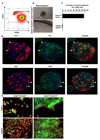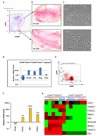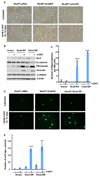The epithelial-mesenchymal transition generates cells with properties of stem cells
- PMID: 18485877
- PMCID: PMC2728032
- DOI: 10.1016/j.cell.2008.03.027
The epithelial-mesenchymal transition generates cells with properties of stem cells
Abstract
The epithelial-mesenchymal transition (EMT) is a key developmental program that is often activated during cancer invasion and metastasis. We here report that the induction of an EMT in immortalized human mammary epithelial cells (HMLEs) results in the acquisition of mesenchymal traits and in the expression of stem-cell markers. Furthermore, we show that those cells have an increased ability to form mammospheres, a property associated with mammary epithelial stem cells. Independent of this, stem cell-like cells isolated from HMLE cultures form mammospheres and express markers similar to those of HMLEs that have undergone an EMT. Moreover, stem-like cells isolated either from mouse or human mammary glands or mammary carcinomas express EMT markers. Finally, transformed human mammary epithelial cells that have undergone an EMT form mammospheres, soft agar colonies, and tumors more efficiently. These findings illustrate a direct link between the EMT and the gain of epithelial stem cell properties.
Figures





Comment in
-
Epithelial-mesenchymal transition and the stem cell phenotype.Cell Stem Cell. 2008 Jun 5;2(6):511-2. doi: 10.1016/j.stem.2008.05.007. Cell Stem Cell. 2008. PMID: 18522839
-
The changing faces of cancer cells.Nat Rev Mol Cell Biol. 2010 Jul;11(7):466. doi: 10.1038/nrm2923. Epub 2010 Jun 16. Nat Rev Mol Cell Biol. 2010. PMID: 20551963 No abstract available.
Similar articles
-
PARP3 controls TGFβ and ROS driven epithelial-to-mesenchymal transition and stemness by stimulating a TG2-Snail-E-cadherin axis.Oncotarget. 2016 Sep 27;7(39):64109-64123. doi: 10.18632/oncotarget.11627. Oncotarget. 2016. PMID: 27579892 Free PMC article.
-
Breast cancer stem cells transition between epithelial and mesenchymal states reflective of their normal counterparts.Stem Cell Reports. 2013 Dec 27;2(1):78-91. doi: 10.1016/j.stemcr.2013.11.009. eCollection 2014 Jan 14. Stem Cell Reports. 2013. PMID: 24511467 Free PMC article.
-
Epithelial-mesenchymal transition and the stem cell phenotype.Cell Stem Cell. 2008 Jun 5;2(6):511-2. doi: 10.1016/j.stem.2008.05.007. Cell Stem Cell. 2008. PMID: 18522839
-
Epithelial-mesenchymal transition and cancer stem cells: a dangerously dynamic duo in breast cancer progression.Breast Cancer Res. 2011 Feb 8;13(1):202. doi: 10.1186/bcr2789. Breast Cancer Res. 2011. PMID: 21392411 Free PMC article. Review.
-
Mammary gland stem cells: more puzzles than explanations.J Biosci. 2012 Jun;37(2):349-58. doi: 10.1007/s12038-012-9200-z. J Biosci. 2012. PMID: 22581339 Review.
Cited by
-
Bone sialoprotein facilitates anoikis resistance in lung cancer by inhibiting miR-150-5p expression.J Cell Mol Med. 2024 Oct;28(20):e70155. doi: 10.1111/jcmm.70155. J Cell Mol Med. 2024. PMID: 39466654 Free PMC article.
-
RAB4A is a master regulator of cancer cell stemness upstream of NUMB-NOTCH signaling.Cell Death Dis. 2024 Oct 27;15(10):778. doi: 10.1038/s41419-024-07172-w. Cell Death Dis. 2024. PMID: 39463384 Free PMC article.
-
Stemness in solid malignancies: coping with immune attack.Nat Rev Cancer. 2024 Oct 25. doi: 10.1038/s41568-024-00760-0. Online ahead of print. Nat Rev Cancer. 2024. PMID: 39455862 Review.
-
Targeted therapy approaches for epithelial-mesenchymal transition in triple negative breast cancer.Front Oncol. 2024 Oct 10;14:1431418. doi: 10.3389/fonc.2024.1431418. eCollection 2024. Front Oncol. 2024. PMID: 39450256 Free PMC article. Review.
-
Circulating tumor cells in pancreatic cancer: more than liquid biopsy.Ther Adv Med Oncol. 2024 Oct 9;16:17588359241284935. doi: 10.1177/17588359241284935. eCollection 2024. Ther Adv Med Oncol. 2024. PMID: 39421679 Free PMC article. Review.
References
-
- Batlle E, Sancho E, Franci C, Dominguez D, Monfar M, Baulida J, Garcia De Herreros A. The transcription factor snail is a repressor of E-cadherin gene expression in epithelial tumour cells. Nat Cell Biol. 2000;2:84–89. - PubMed
-
- Bonnet D, Dick JE. Human acute myeloid leukemia is organized as a hierarchy that originates from a primitive hematopoietic cell. Nature medicine. 1997;3:730–737. - PubMed
-
- Brabletz T, Jung A, Spaderna S, Hlubek F, Kirchner T. Opinion: migrating cancer stem cells - an integrated concept of malignant tumour progression. Nat Rev Cancer. 2005;5:744–749. - PubMed
-
- Briegel KJ. Embryonic transcription factors in human breast cancer. IUBMB life. 2006;58:123–132. - PubMed
Publication types
MeSH terms
Substances
Grants and funding
- R01-CA078461/CA/NCI NIH HHS/United States
- P01 CA080111/CA/NCI NIH HHS/United States
- P50 CA089393-080014/CA/NCI NIH HHS/United States
- P01 CA080111-09/CA/NCI NIH HHS/United States
- R01 CA116235-02/CA/NCI NIH HHS/United States
- CA94074/CA/NCI NIH HHS/United States
- CA89393/CA/NCI NIH HHS/United States
- P0-CA080111/CA/NCI NIH HHS/United States
- R01 CA116235-01A1/CA/NCI NIH HHS/United States
- R01 CA116235-03/CA/NCI NIH HHS/United States
- P50 CA089393/CA/NCI NIH HHS/United States
- R01 CA116235/CA/NCI NIH HHS/United States
- P50 CA089393-070014/CA/NCI NIH HHS/United States
- R01 CA078461/CA/NCI NIH HHS/United States
- P50 CA089393-060014/CA/NCI NIH HHS/United States
- R01 CA094074/CA/NCI NIH HHS/United States
- R01 CA078461-09/CA/NCI NIH HHS/United States
LinkOut - more resources
Full Text Sources
Other Literature Sources
Medical
Research Materials
Miscellaneous

